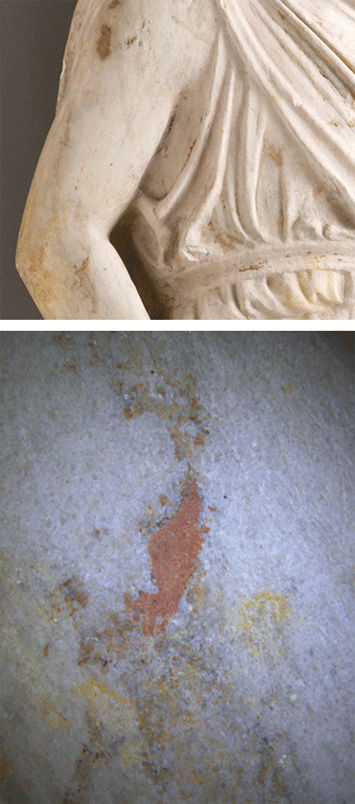From the Trenches
Seeds of Europe's Family Tree
By NIKHIL SWAMINATHAN
Friday, June 07, 2013
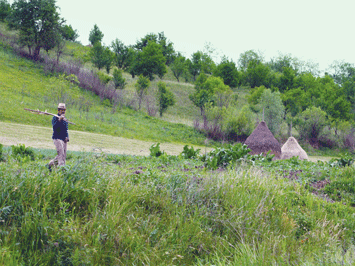 For 20 years, scientists have been attempting to connect modern Europeans’ genetic lineage to either Paleolithic hunter-gatherers who arrived before the last Ice Age, 22,000 years ago, or to the continent’s first farmers, who appeared 7,500 years ago, in the early Neolithic. Australian scientists now say that today’s Europeans may be related to an even later wave of settlers. Scientists retrieved mitochondrial DNA, which passes from mother to child, from the remains of 39 people recovered from archaeological digs in central Europe, covering a 3,500-year span throughout the Neolithic. They identified a particular complex of genes shared by 40 percent of the modern population. These genes display a level of diversity that did not exist among the early hunter-gatherers and was not prominent among the first farmers. It is in later periods of the Neolithic, from about 6,000 to 4,000 years ago, that today’s variants start to pop up regularly.
For 20 years, scientists have been attempting to connect modern Europeans’ genetic lineage to either Paleolithic hunter-gatherers who arrived before the last Ice Age, 22,000 years ago, or to the continent’s first farmers, who appeared 7,500 years ago, in the early Neolithic. Australian scientists now say that today’s Europeans may be related to an even later wave of settlers. Scientists retrieved mitochondrial DNA, which passes from mother to child, from the remains of 39 people recovered from archaeological digs in central Europe, covering a 3,500-year span throughout the Neolithic. They identified a particular complex of genes shared by 40 percent of the modern population. These genes display a level of diversity that did not exist among the early hunter-gatherers and was not prominent among the first farmers. It is in later periods of the Neolithic, from about 6,000 to 4,000 years ago, that today’s variants start to pop up regularly.
According to Wolfgang Haak, a molecular archaeologist at the University of Adelaide, this tells us that early Neolithic farmers failed to cement their genetic legacy in central Europe, but that new settlers, possibly bringing related industries such as wool and dairy production, did. “It is not unlikely to assume a constant genetic influx from surrounding areas as settlement density increased towards the end the Neolithic,” Haak explains, “or that further technological advances arrived later.”
Origins of the Maya
By ZACH ZORICH
Monday, June 10, 2013
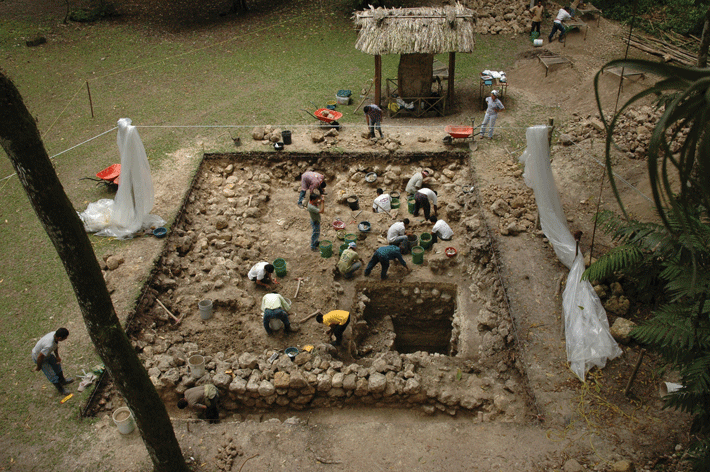 A team of archaeologists led by Takeshi Inomata of the University of Arizona has excavated evidence of the origins of Maya culture at the ancient city of Ceibal in Guatemala. Over seven years, Inomata’s team has uncovered parts of the earliest buildings in the city’s ceremonial center. Radiocarbon dates show that the site was first occupied around 1000 b.c., making it the earliest known Maya site with a ceremonial center. The team found that the earliest architecture there conforms to a pattern that is also found at a contemporary non-Maya site in Chiapas, Mexico, and in the Olmec city of La Venta, which was built 200 years later. The team interprets this to mean that Maya culture grew out of a complex web of influences from across the region. Inomata says, “We are looking at the crystallization of the hallmarks of Mesoamerican civilizations, including pyramids, formal ceremonial complexes, and public rituals in the plaza.”
A team of archaeologists led by Takeshi Inomata of the University of Arizona has excavated evidence of the origins of Maya culture at the ancient city of Ceibal in Guatemala. Over seven years, Inomata’s team has uncovered parts of the earliest buildings in the city’s ceremonial center. Radiocarbon dates show that the site was first occupied around 1000 b.c., making it the earliest known Maya site with a ceremonial center. The team found that the earliest architecture there conforms to a pattern that is also found at a contemporary non-Maya site in Chiapas, Mexico, and in the Olmec city of La Venta, which was built 200 years later. The team interprets this to mean that Maya culture grew out of a complex web of influences from across the region. Inomata says, “We are looking at the crystallization of the hallmarks of Mesoamerican civilizations, including pyramids, formal ceremonial complexes, and public rituals in the plaza.”
Off the Grid
By MALIN GRUNBERG BANYASZ
Monday, June 10, 2013
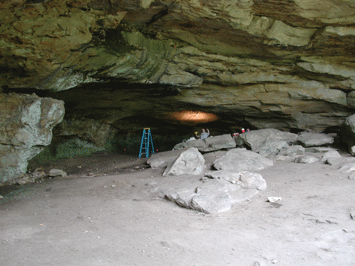 Many people probably associate rock art in the United States with the arid vistas of the Southwest, but it can be found elsewhere, such as on a forested mountain in central Arkansas. At Petit Jean Mountain, in a state park of the same name, there are dozens of beautiful old Native American rock art sites. Most of these sites are little known to visitors—anonymity helps protect against graffiti and vandalism—but one site is particularly accessible: Rock House Cave. According to Ann Marie Early, the state archaeologist, and George Sabo III of the Arkansas Archeological Survey, visitors to Rock House Cave can see more than a hundred pictographs, both abstract and figurative, that date to the first half of the seventeenth century.
Many people probably associate rock art in the United States with the arid vistas of the Southwest, but it can be found elsewhere, such as on a forested mountain in central Arkansas. At Petit Jean Mountain, in a state park of the same name, there are dozens of beautiful old Native American rock art sites. Most of these sites are little known to visitors—anonymity helps protect against graffiti and vandalism—but one site is particularly accessible: Rock House Cave. According to Ann Marie Early, the state archaeologist, and George Sabo III of the Arkansas Archeological Survey, visitors to Rock House Cave can see more than a hundred pictographs, both abstract and figurative, that date to the first half of the seventeenth century.
The site
Rock House Cave can be found alongside the Cedar Falls Trail, which begins at the parking area of Petit Jean State Park. It is not a cave per se, but one of the largest sandstone bluff shelters in the state: 85 feet long and 100 feet deep, with a 16-foot ceiling. Most of the pictographs on its walls are red, probably pigmented with red ochre, and painted with either fingers or frayed twigs. The art is composed of geometric shapes and meandering lines, as well as remarkably realistic animal depictions. One of these is a life-size painting of a paddlefish, or spoonbill catfish, 36 inches long. Beneath it is a depiction of an open-weave basket thought to be a fish trap. Sabo says that the size of Rock House Cave suggests that it might have been a gathering place—though it’s not clear what community used it. Excavations at Carden Bottoms, at the foot of Petit Jean Mountain, have uncovered seventeenth-century pottery decorated with motifs similar to those painted in the cave. Some believe that Carden Bottoms hosted a multiethnic community that included ancestors of the Osage, Caddo, Quapaw, and others.
While you’re there
The trail that passes by Rock House Cave (one of 10 official trails in the park) winds from scenic Cedar Creek Falls to the rustic, renovated Mather Lodge, where visitors can rent cabins or have dinner overlooking the canyon. Just west of Petit Jean Mountain is Holla Bend National Wildlife Refuge, which attracts large flocks of migrating birds, including 100,000 ducks and geese, as well as songbirds, wading birds, and, in winter, bald eagles. Little Rock, 70 miles southeast, is home to the William J. Clinton Presidential Library and numerous museums. And 15 miles more will bring you to Toltec Mounds State Park, a prehistoric Woodland complex with a museum—one of the largest prehistoric sites in the lower Mississippi River Valley.
Chilling Discovery at Jamestown
By ERIC A. Powell
Monday, June 10, 2013
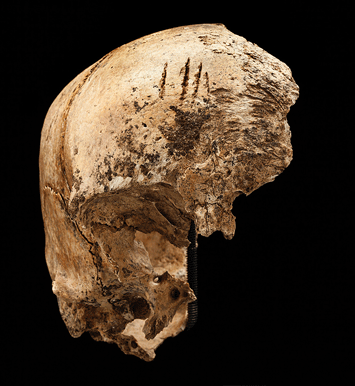 In the fall of 1609, Powhatan Indians laid siege to Jamestown, Virginia, trapping 300 settlers inside the settlement’s fort. Cut off from food supplies, only 60 would survive the winter ahead, known to history as the “Starving Time.” According to survivors’ accounts, they consumed vermin and boot leather, and, as the winter grew harsher, some ate the dead. But firsthand reports can be unreliable and there has never been direct evidence for cannibalism at Jamestown. “I never believed those accounts,” says William Kelso, chief archaeologist for the Jamestown Rediscovery Project. “I thought they were trying to make the Virginia Company [the colony’s sponsor] feel bad so they would send more supplies.”
In the fall of 1609, Powhatan Indians laid siege to Jamestown, Virginia, trapping 300 settlers inside the settlement’s fort. Cut off from food supplies, only 60 would survive the winter ahead, known to history as the “Starving Time.” According to survivors’ accounts, they consumed vermin and boot leather, and, as the winter grew harsher, some ate the dead. But firsthand reports can be unreliable and there has never been direct evidence for cannibalism at Jamestown. “I never believed those accounts,” says William Kelso, chief archaeologist for the Jamestown Rediscovery Project. “I thought they were trying to make the Virginia Company [the colony’s sponsor] feel bad so they would send more supplies.”
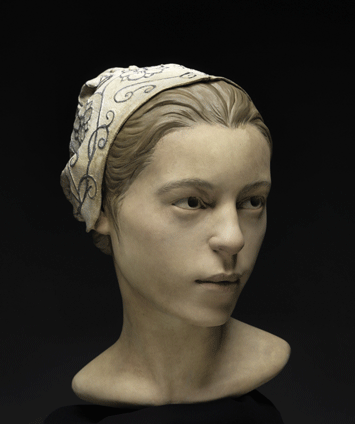 Now the discovery of a partial human skull and tibia in a kitchen cellar inside the fort has substantiated the survivors’ claims. Kelso’s team found the remains, which belonged to a 14-year-old girl, in a trash pile with the bones of butchered horses, dogs, rats, and mice. Someone trying to separate flesh from the bones with a knife left marks on the skull, jawbone, and tibia. The marks appear to have been made inexpertly, or by someone who was hesitating to butcher the bones. “There’s no question that this is evidence for survival cannibalism,” says Kelso. “It’s grim and it’s a tough story to handle. But it points out just how close Jamestown came to failing.”
Now the discovery of a partial human skull and tibia in a kitchen cellar inside the fort has substantiated the survivors’ claims. Kelso’s team found the remains, which belonged to a 14-year-old girl, in a trash pile with the bones of butchered horses, dogs, rats, and mice. Someone trying to separate flesh from the bones with a knife left marks on the skull, jawbone, and tibia. The marks appear to have been made inexpertly, or by someone who was hesitating to butcher the bones. “There’s no question that this is evidence for survival cannibalism,” says Kelso. “It’s grim and it’s a tough story to handle. But it points out just how close Jamestown came to failing.”
Not Quite Ancient
By JARRETT A. LOBELL
Monday, June 10, 2013
When University of Georgia archaeologist Mark Abbe first saw the fragment of sculpture at the University of Mississippi Museum, the light was low and he didn’t get a very good look. Yet Abbe was intrigued by the faint traces of color he saw on its white marble surface. At the time, he couldn’t have imagined why the relief struck him as different from the thousands of other ancient sculptures he had seen. Wanting to know more, museum Director Robert Saarnio allowed Abbe to bring the relief to the Georgia Museum of Art in Athens. “As soon as I got it back here under good light, I thought, ‘Wait a second, this isn’t like anything I have seen before,’” says Abbe.
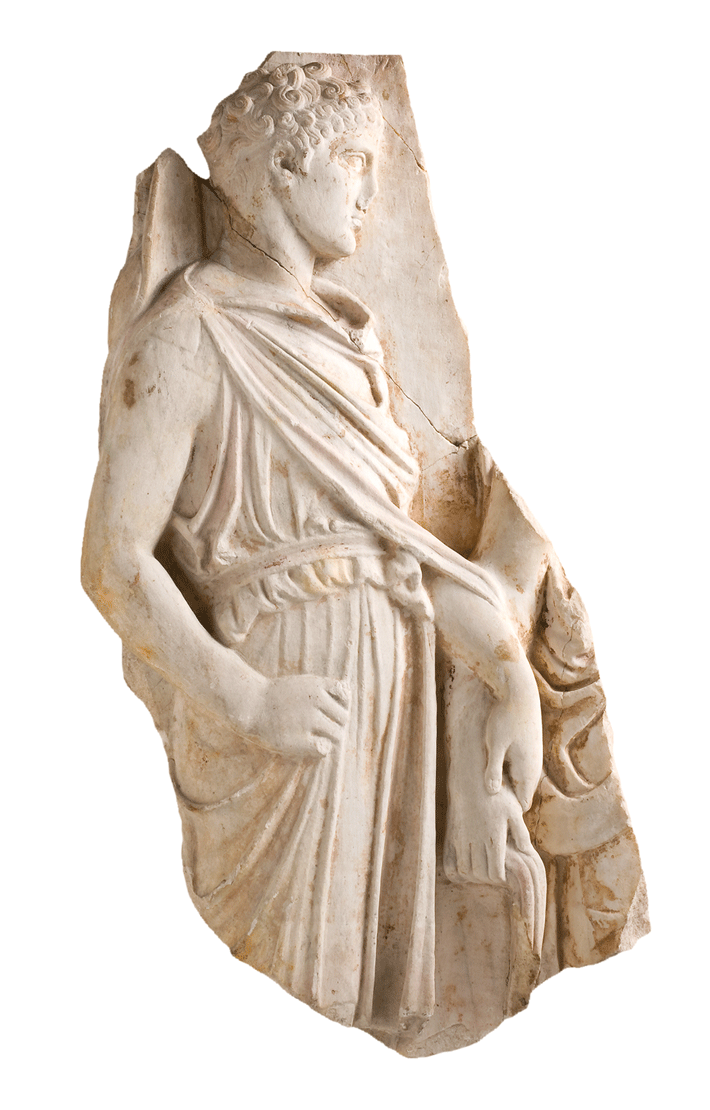
While only the section depicting the god Hermes exists, the fragment is actually part of a celebrated ancient composition known as the “Orpheus Relief.” This scene shows Hermes leading the nymph Eurydice back to the underworld after her final parting from her beloved Orpheus. Back in Athens, Abbe and Jeff Speakman of the Center for Applied Isotope Studies used hyperspectral imaging techniques to collect data beyond what the human eye can see. When combined with chemist Tina Salguero’s study of minute traces of pigment, the results were a complete surprise—what had always been thought to be a first-century Roman copy of a late fifth-century B.C. Greek original, had, in fact, been made between 1880 and 1920. “As soon as we saw pigments without ancient parallels, such as titanium white and phthalocyanine blue, we knew the paint wasn’t ancient,” explains Abbe. As he continued to examine the sculpture, he began to realize that it wasn’t just the pigments that weren’t right—the piece could still have been ancient, with the paint added for the marketplace thousands of years later. “At first it just looked like an over-scrubbed ancient artifact, but the more we looked at the surfaces, we realized they weren’t akin to Roman practice,” Abbe says.
Advertisement
Advertisement
IN THIS ISSUE
From the Trenches
Not Quite Ancient
Off the Grid
Chilling Discovery at Jamestown
Origins of the Maya
Seeds of Europe's Family Tree
France’s Wealthy Warriors
Did the “Father of History” Get It Wrong?
Apollo Returns from the Abyss
Afterlife of a Dignitary
Spain's Lead-Lined Lakes
In Style in the Stone Age
Portals to the Underworld
Roman London Underground
Whale-Barnacle Barbecue
The Human Mosaic
Advertisement

Recent Issues
-
 May/June 2024
May/June 2024
-
 March/April 2024
March/April 2024
-
 January/February 2024
January/February 2024
-
 November/December 2023
November/December 2023
-
 September/October 2023
September/October 2023
-
 July/August 2023
July/August 2023
-
 May/June 2023
May/June 2023
-
 March/April 2023
March/April 2023
-
 January/February 2023
January/February 2023
-
 November/December 2022
November/December 2022
-
 September/October 2022
September/October 2022
-
 July/August 2022
July/August 2022
-
 May/June 2022
May/June 2022
-
 March/April 2022
March/April 2022
-
 January/February 2022
January/February 2022
-
 November/December 2021
November/December 2021
-
 September/October 2021
September/October 2021
-
 July/August 2021
July/August 2021
-
 May/June 2021
May/June 2021
-
 March/April 2021
March/April 2021
-
 January/February 2021
January/February 2021
-
 November/December 2020
November/December 2020
-
 September/October 2020
September/October 2020
-
 July/August 2020
July/August 2020
-
 May/June 2020
May/June 2020
-
 March/April 2020
March/April 2020
-
 January/February 2020
January/February 2020
-
 November/December 2019
November/December 2019
-
 September/October 2019
September/October 2019
-
 July/August 2019
July/August 2019
-
 May/June 2019
May/June 2019
-
 March/April 2019
March/April 2019
-
 January/February 2019
January/February 2019
-
 November/December 2018
November/December 2018
-
 September/October 2018
September/October 2018
-
 July/August 2018
July/August 2018
-
 May/June 2018
May/June 2018
-
 March/April 2018
March/April 2018
-
 January/February 2018
January/February 2018
-
 November/December 2017
November/December 2017
-
 September/October 2017
September/October 2017
-
 July/August 2017
July/August 2017
-
 May/June 2017
May/June 2017
-
 March/April 2017
March/April 2017
-
 January/February 2017
January/February 2017
-
 November/December 2016
November/December 2016
-
 September/October 2016
September/October 2016
-
 July/August 2016
July/August 2016
-
 May/June 2016
May/June 2016
-
 March/April 2016
March/April 2016
-
 January/February 2016
January/February 2016
-
 November/December 2015
November/December 2015
-
 September/October 2015
September/October 2015
-
 July/August 2015
July/August 2015
-
 May/June 2015
May/June 2015
-
 March/April 2015
March/April 2015
-
 January/February 2015
January/February 2015
-
 November/December 2014
November/December 2014
-
 September/October 2014
September/October 2014
-
 July/August 2014
July/August 2014
-
 May/June 2014
May/June 2014
-
 March/April 2014
March/April 2014
-
 January/February 2014
January/February 2014
-
 November/December 2013
November/December 2013
-
 September/October 2013
September/October 2013
-
 July/August 2013
July/August 2013
-
 May/June 2013
May/June 2013
-
 March/April 2013
March/April 2013
-
 January/February 2013
January/February 2013
-
 November/December 2012
November/December 2012
-
 September/October 2012
September/October 2012
-
 July/August 2012
July/August 2012
-
 May/June 2012
May/June 2012
-
 March/April 2012
March/April 2012
-
 January/February 2012
January/February 2012
-
 November/December 2011
November/December 2011
-
 September/October 2011
September/October 2011
-
 July/August 2011
July/August 2011
-
 May/June 2011
May/June 2011
-
 March/April 2011
March/April 2011
-
 January/February 2011
January/February 2011
Advertisement





